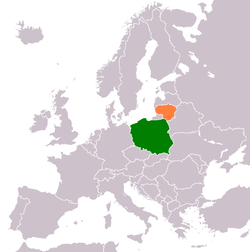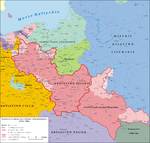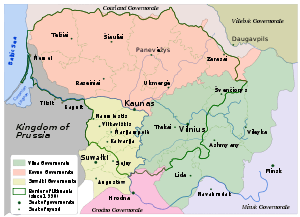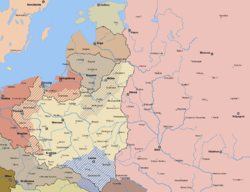Lithuania–Poland relations
 |
|
Poland |
Lithuania |
|---|---|
Polish–Lithuanian relations date from the 13th century, after the Grand Duchy of Lithuania under Mindaugas acquired some of the territory of Rus' and thus established a border with the then-fragmented Kingdom of Poland. Polish-Lithuanian relations subsequently improved, ultimately leading to a personal union between the two states. From the mid-16th to the late-18th century Poland and Lithuania merged to form the Polish–Lithuanian Commonwealth, a state that was dissolved following their partition by Austria, Prussia and Russia. After the two states regained independence following the First World War, Polish-Lithuanian relations steadily worsened due to rising nationalist sentiments. Competing claims to the Vilnius region led to armed conflict and deteriorating relations in the interwar period. During the Second World War Polish and Lithuanian territories were occupied by both the Soviet Union and Nazi Germany, but relations between Poles and Lithuanians remained hostile. Following the end of World War II, both Poland and Lithuania found themselves in the Eastern Bloc, Poland as a Soviet satellite state, Lithuania as a Soviet republic. With the fall of communism relations between the two countries were reestablished.
History
Borders
 Map of Poland from the early 11th century shows Polish and Lithuanian lands separated by Old Prussian and Kiev Russian territories
Map of Poland from the early 11th century shows Polish and Lithuanian lands separated by Old Prussian and Kiev Russian territories.png) Map of Poland in the first half of the 13th century, shows a border between Duchy of Masovia and Lithuania
Map of Poland in the first half of the 13th century, shows a border between Duchy of Masovia and Lithuania.png) Map of Poland and Lithuania around 1275-1300, with visible Polish-Lithuanian border
Map of Poland and Lithuania around 1275-1300, with visible Polish-Lithuanian border Map of Poland and Lithuania around 1333 - 1370, with visible Polish-Lithuanian border
Map of Poland and Lithuania around 1333 - 1370, with visible Polish-Lithuanian border Map of Poland and Lithuania around 1370 - 1382, with visible Polish-Lithuanian border
Map of Poland and Lithuania around 1370 - 1382, with visible Polish-Lithuanian border Map of Poland and Lithuania around 1386 - 1434, with visible Polish-Lithuanian border
Map of Poland and Lithuania around 1386 - 1434, with visible Polish-Lithuanian border- Map of Poland and Lithuania around 1466, with visible Polish-Lithuanian border
- Map of Poland and Lithuania around 1526, with visible Polish-Lithuanian border
 Map of Polish-Lithuania Commonwealth after its formation in 1569, with visible Polish-Lithuanian border. Ukrainian territories were transferred under the administrative control of the Crown of Poland.
Map of Polish-Lithuania Commonwealth after its formation in 1569, with visible Polish-Lithuanian border. Ukrainian territories were transferred under the administrative control of the Crown of Poland. Map of Lithuania around 1867-1914, with visible Polish-Russian border (Lithuania did not exist at that time)
Map of Lithuania around 1867-1914, with visible Polish-Russian border (Lithuania did not exist at that time) Polish-Lithuanian border around 1918-1939
Polish-Lithuanian border around 1918-1939
Middle ages
Lithuanian state dates to the 13th century, and it first established a border with Polish territories around the 14th century, after the destruction of the Old Prussian and Yotvingians tribes. Until that time most of contact between the two countries was limited to border military conflicts, such as Lithuanian raid on Duchy of Masovia in 1262, which killed Siemowit I of Masovia.[1] This changed with a mid-1320s alliance between king of Poland, Władysław Łokietek, and Grand Duke of Lithuania, Gediminas.[2] Gediminas daughter Aldona married Władysław Łokietek's son and future successor, Casimir III of Poland, in 1325, which led to improved relations.[2][3] In 1358 a treaty between Duchy of Masovia and Grand Duchy of Lithuania outlined a border between the two for the first time.[4] In 1385 the growing threat of the Teutonic Order to both countries led to a firmer alliance, the Union of Krewo, which signaled the beginning of a centuries-long Polish–Lithuanian union.[5] This alliance was strengthened by the Polish-Lithuanian victory of the Teutonic Knights in the 1410 battle of Grunwald.[5]
As Lithuania was increasingly threatened by the Muscovy (see Lithuanian-Muscovite Wars), it sought to strengthen its ties with Poland.[5] The union reached an important milestone in 1569, when the Union of Lublin created a new federal state, the Polish–Lithuanian Commonwealth,[5] which lasted until the Constitution of May 3, 1791 and partitions.[5] The period of the partitions saw the reversal of the previous process of polonization, with the Lithuanian National Revival, giving new prominence to the Lithuanian language and culture.[5]
Interbellum



Despite federation proposals such as Międzymorze, after the First World War Lithuania chose to pursue independent statehood instead of recreating a previous union. Differences on border issues, particularly over the cities of Vilnius (Wilno) and Sejny (Seinai) led to the Polish-Lithuanian War and worsened relations for most of the interwar period.[5][6]
Lithuanian–Polish relations continued to deteriorate, as Polish and Lithuanian forces skirmished in the background of the Polish-Soviet War (and Lithuanian-Soviet War). Polish Military Organization staged Sejny Uprising was met with massive outrage in Lithuania.[7] Furthermore, the image of Poles deteriorated because of the uncovered plot to overthrow sovereign Lithuanian government by the Polish Military Organization, supported by the local Polish minority. The relations worsened further still as the Polish-Lithuanian War erupted, and Józef Piłsudski ordered Żeligowski's Mutiny.[6] In the aftermath of the Polish annexation of the Republic of Central Lithuania, Lithuania severed diplomatic relations with Poland.[6] Poland and Lithuania experienced notable crisis' in their relationship in 1927 (where a threat of renewed hostilities led to partial restoration of the diplomatic relations) and 1938 (when the 1938 Polish ultimatum to Lithuania forced Lithuania to agree to full restoration of the diplomatic relations).[6] The League of Nations was involved in smoothing over the conflicts in 1919-20 and 1927.[6]
After the events of 1919-20, Polish actions and the Poles themselves were viewed with a high level of suspicion in Lithuania, and vice versa. Both governments - in the era nationalism swept through Europe - treated their respective minorities harshly. In Lithuania, people declaring Polish ethnicity were officially described as Lithuanians who merely needed to be re-Lithuanianized, Polish-owned land were confiscated, Polish religious services, schools, publications, and voting rights were restricted.[8] After Piłsudski's death, between 1935 and 1939, the Lithuanian minority in Poland was an object of Polonisation, with the government encouraging settlement of Polish army veterans in disputed regions.[9] Almost all Lithuanian schools were closed (266) and almost all Lithuanian organizations were banned.[9]
World War II
The issue of Polish and Lithuanian relations during the Second World War is a controversial one, and some modern Lithuanian and Polish historians still differ in their interpretations of the related events, many of which are related to the treatment of Poles by the Lithuanian Nazi-collaborationist government and security forces, and the operations of Polish resistance organization of Armia Krajowa on territories inhabited by Lithuanians and Poles. In recent years a number of common academic conferences have started to bridge the gap between Lithuanian and Polish interpretations, but significant differences still remain.[10]
Communist era
The Second World War put an end to independent Polish and Lithuanian states. After the war, both former states fell under the sphere of influence of Soviet Union. Poland was shifted westwards, thus giving up most of the disputed territories previously containing significant Lithuanian minority in the Second Polish Republic, those territories were incorporated into Lithuanian SSR and Belarus SSR, itself one of the Soviet republics. At the same time many Poles from Kresy were allowed to leave the Soviet Union, and mostly were transferred west to Recovered Territories, and the Polish minority in Lithuania (or Lithuanian SSR) was also significantly downsized.[5] The remaining Polish minority in Lithuania became subject to Lithuanization and Sovietization policies.[5] Under the eye of the Soviet Union, the various ethnic groups in the Eastern Bloc were to cooperate peacefully. To prevent creation or recreation of historical alliances that could weaken the Soviet regime, Soviet policy was aimed at minimizing the role of the historical ties between those nations, and there were few contacts of any significance between Poland and Lithuania during that period.[5]
Modern times
.jpg)
The fall of communism in the years between 1989 and 1991 led to a formal reestablishment of relations by the Polish and Lithuanian states. Poland was highly supportive of Lithuanian independence, and became one of the first countries to recognize independent Lithuania (on 26 August 1991).[5][11] Despite that, there was a relative crisis in the early 1990s, due to alleged Lithuanian mistreatment of its Polish minority, and Lithuanian concerns that Poland sought again to put Lithuania under its sphere of influence, or even issue territorial claims.[5][11] After a few years, the situation normalized, and relations improved.[12] On 28 September 1992 the foreign ministers of both nations signed a declaration of friendship and neighborly relations and a consular convention, rejecting any territorial claims and promising to respect the rights of their corresponding minorities.[11] On 26 April 1994 during the meeting of presidents of both countries in Vilnius they concluded the mutual Friendship Treaty.[13] Both countries joining the NATO (Poland in 1999, Lithuania in 2004, with Poland being a vocal supporter of Lithuania's accession[12]) and European Union (both in 2004).
However, in the late 2000s, disagreements over Lithuania's implementation of the Friendship Treaty have soured relations and cooperation on energy issues. The electricity grids of Poland and Lithuania are inter-connected[14] but the gas pipelines of the two countries are only connected through a Russian-controlled gas pipeline. Previously stated intentions have been stalled by the row over the Friendship Treaty.[15][16][17] Polish president Bronisław Komorowski during a visit to Lithuania in February 2011 expressed concerns over the deterioration of relations, and noted that the full implementation of the Friendship Treaty should allow Poles in Lithuania to use the original forms of their surnames and to access education in Polish language.[18] In case C-391/09 - Runevič-Vardyn and Wardyn the European Court of Justice ruled that the Lithuanian policy on surnames conforms to the EU law.
Lithuania has an embassy in Warsaw. Poland has an embassy in Vilnius, a consulate general in Sejny and an honorary consulate in Klaipėda. There are around 250,000 Poles living in Lithuania and around 25,000 ethnic Lithuanians living in Poland. Both countries are full members of the Council of the Baltic Sea States.
Both countries share a common border of 103 km.[19] Because both are part of the Schengen Area, there are no border controls between the countries.
Notes
- ↑ Kronika zamkowa. Arx Regia, Ośrodek Wydawniczy Zamku Królewskiego w Warszawie. 2007. p. 36.
- 1 2 Frank N. Magill (12 November 2012). The Middle Ages: Dictionary of World Biography. Routledge. p. 209. ISBN 978-1-136-59313-0.
- ↑ Saulius A. Suziedelis (7 February 2011). Historical Dictionary of Lithuania. Scarecrow Press. p. 334. ISBN 978-0-8108-7536-4.
- ↑ Loreta Daukšytė (2010). The Borders of Lithuania: The History of a Millennium. "Baltų lankų" leidyba. p. 12. ISBN 978-9955-23-346-6.
- 1 2 3 4 5 6 7 8 9 10 11 12 Stephen R. Burant and Voytek Zubek, Eastern Europe's Old Memories and New Realities: Resurrecting the Polish-lithuanian Union, East European Politics and Societies 1993; 7; 370, online
- 1 2 3 4 5 Michael Brecher, Jonathan Wilkenfeld, A Study of Crisis, University of Michigan Press, 1997, ISBN 0-472-10806-9, Google Print, p.252-255
- ↑ Lesčius, Vytautas; Editors: dr. Gintautas Surgailis; habil. dr. prof. Algirdas Ažubalis; habil. dr. prof. Grzegorz Błaszczyk; dr. doc. Pranas Jankauskas; dr. Eriks Jekabsons; habil. dr. prof. Waldemar Rezmer and others (2003). "Lietuvos ir Lenkijos krainis konfliktas del Seinu krasto 1919 metais". Karo archyvas XVIII (PDF). Vilnius: Generolo Jono Žemaičio Lietuvos karo akademija. pp. 188–189. ISSN 1392-6489. Cite uses deprecated parameter
|coauthors=(help) - ↑ Fearon, James D.; Laitin, David D. (2006). "Lithuania" (pdf). Stanford University. p. 4. Retrieved 2007-06-18.
Lithuanian nationalists resented demands by Poles for greater cultural autonomy (similar to that granted to the Jewish minority), holding that most of Lithuania's Poles were really deracinated Lithuanians who merely needed to be re-Lithuanianized. Resentments were exacerbated when Lithuanian Poles expressed a desire to "re-unite" the country with Poland. As a result, the nationalizing Lithuanian state took measures to confiscate Polish-owned land. It also restricted Polish religious services, schools, Polish publications, Polish voting rights. Poles were often referred to in the press in this period as the "lice of the nation"
- 1 2 Fearon, James D.; Laitin, David D. (2006). "Lithuania" (pdf). Stanford University. p. 4. Retrieved 2007-06-18.
From 1936 till 1939, 266 Lithuanian schools were closed in the entire territory of the former Vilnius Territory. Activities of almost all Lithuanian cultural organizations were banned there. In the areas controlled by Poland, resentments grew as a new settlement of Polish army veterans with economic ties to Poland brought greater Polonization.
- ↑ Dovile, Budryte (September 30, 2005). Taming Nationalism?. Ashgate Publishing, Ltd. pp. 188–189. ISBN 0-7546-4281-X.
- 1 2 3 Glenn E. Curtis (ed.), Polish foreign relations with the former Soviet Republics, Poland: A Country Study, Washington: GPO for the Library of Congress, 1992
- 1 2 Timothy Snyder (2004). The reconstruction of nations: Poland, Ukraine, Lithuania, Belarus, 1569-1999. Yale University Press. pp. 284–286. ISBN 978-0-300-10586-5. Retrieved 17 February 2011.
- ↑ Alexandra Ashbourne (1999). Lithuania: the rebirth of a nation, 1991-1994. Lexington Books. pp. 87–. ISBN 978-0-7391-0027-1. Retrieved 17 February 2011.
- ↑ New electricity connections between Lithuania, Poland and Sweden create "Baltic Ring"
- ↑ Adam Mullett, Spelling law hurting relations with Poland, Baltic Reports, Apr 9, 2010
- ↑ E.L., Poland, Lithuania and self-centredness goes nuclear (updated), Eastern Approaches blog, The Economist, Oct 25th 2010
- ↑ Bad blood: Lithuania and Poland seem to have hit an icy impasse, The Economist, Jan 20th 2011
- ↑ Current disputes must not spoil bilateral relations, says Komorowski, The News.pl, 17.02.2011
- ↑ (Polish) Informacje o Polsce - informacje ogólne. Page gives Polish PWN Encyklopedia as reference.
External links
- Polish-Lithuanian Co-operation - on post-1991 Polish–Lithuanian relations, Polish Embassy in Lithuania
- Lithuanian PM ‘I know what Lithuania’s Poles need’ Andrius Kubilius interview to Gazeta Wyborcza on the relations between two states, 4 November 2010
- B. Dundulis, A historiographic survey of Lithuanian-Polish relations, Lituanus, Lithuanian quarterly journal of arts and sciences, Volume 17, No.4 - Winter 1971
- Joanna Rohozinska, The Conquest of Pragmatism: A new chapter in Polish-Lithuanian relations, Central Europe Review, Vol 1, No 13, 20 September 1999
- Antanas Valionis; Evaldas Ignatavièius; Izolda Brièkovskienë. "From Solidarity to Partnership: Lithuanian-Polish Relations 1988-1998, 1998, issue 2" (PDF). Lithuanian Foreign Policy Review.
- Virgil Krapauskas, Political change in Poland and Lithuania: The impact on Polish-Lithuanian ethnic relations as reflected in Lithuanian-language publications in Poland (1945-1991), Journal of Baltic Studies, Volume 29, Issue 3 Autumn 1998, pages 261 - 278,
- Lithuanian Ministry of Foreign affairs: list of bilateral treaties with Poland (in Lithuanian only)
- Lithuanian embassy in Warsaw
- Lithuanian consulate general in Sejny (in Lithuanian and Polish only)
- Polish embassy in Vilnius
See also
- History of Lithuania and Foreign relations of Lithuania
- History of Poland and Foreign relations of Poland
- Lithuanian minority in Poland and Polish minority in Lithuania
